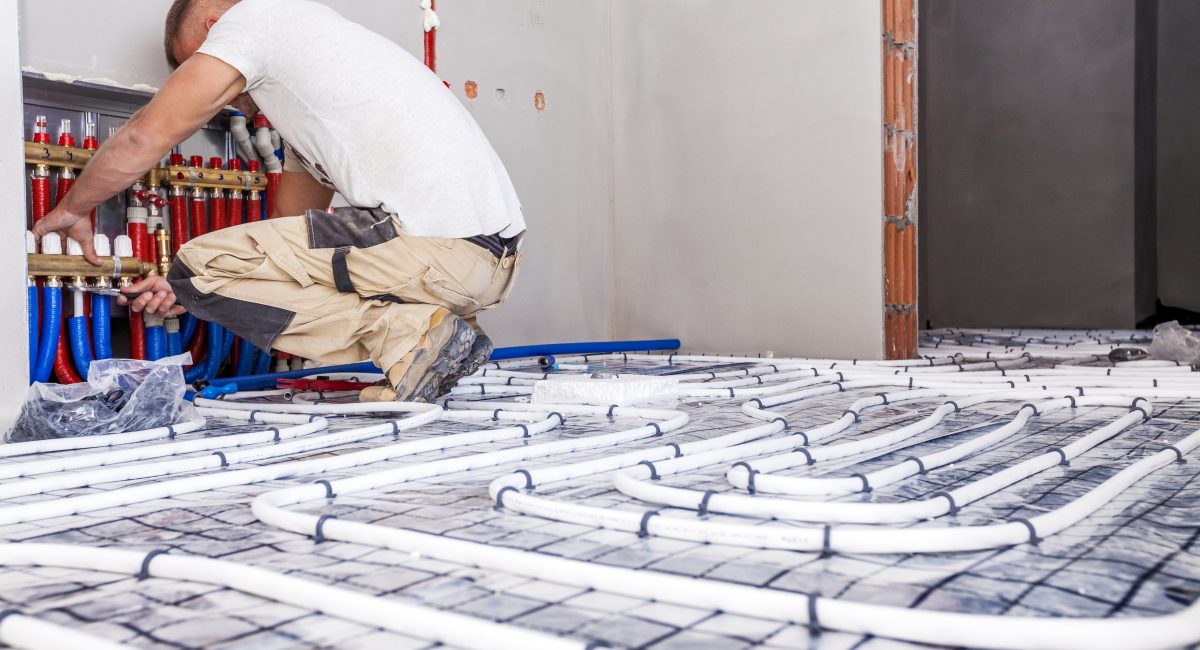Installing Underfloor Heating for a Wooden Floor: A Complete Guide
Wood flooring is a popular choice for both new build projects and retrofitting older properties, and it is often the case that homeowners and contractors have to consider whether or not underfloor heating can be installed for them. We have created this guide to provide more information on underfloor heating and wooden floors, so you can better decide whether or not the combination of timber flooring and a UFH system will be possible for your project.
Read on to learn more, or contact us today if you would like to hear more about the benefits of fitting underfloor heating systems alongside a screed layer from our team of professionals.
Can You Put Underfloor Heating Under Wooden Floors?
This is a common question, and the shortest answer is “yes”. You can put underfloor heating under wooden floors. Timber is capable of effectively transferring heat and releasing it into a room and can therefore be used as a surface if you require underfloor heating.
However, there are some stipulations to this. Different types of wood flooring have specific requirements and some will work better with UFH than others. Because of this, you must ensure you are choosing the right type of wood flooring for your project.
Can You Use UFH Systems with Suspended Floors?
It is possible to install an underfloor heating system if you have suspended floors (many older homes have these, so the UFH system would be a retrofit). It is also important to note that the installation may be more complicated.
If you intend to use a wet underfloor heating system, the floorboards will need to be lifted before the system can be installed. These will then need to be fixed back in place. If the suspended floors being worked on are above the ground floor (for instance, on the first floor) then the heating system can also be laid from underneath.
You may find certain types of hot water underfloor heating systems are designed specifically for use with suspended timber floors. These are often also designed to be fitted between floor joists. All pipework and insulation panels are fitted tightly into the void, with the pipes clipped to the insulation and grooves cut out of the battens to accommodate them.
If the system is to work effectively, it has to be as airtight as possible. A screed mix can be used between the insulation and floorboards to ensure this happens.
Some people also consider using systems that incorporate thin metal plates or chipboard mats holding pipes that are laid directly on top of the floor joists. Most of these floor systems are very thin, but they will inevitably add some height to the finished floor.
Can You Use Electric Underfloor Heating with UFH Systems?
If you would prefer to use electric underfloor heating, rather than wet underfloor heating, these systems can also be fitted underneath a wooden floor.
In the case of suspended floors, the original floorboards become the subfloor. The electric underfloor heating mats will then be laid on top; usually, this will be on a base of plywood or a suitable tile backer board. The new floor finish will then be added over the top.
You need to ensure you are buying a UFH kit or system that is designed specifically for use with solid wood, engineered wood, or laminate flooring. If there is any doubt over whether or not your kit or system fits this description, you should talk to your supplier.
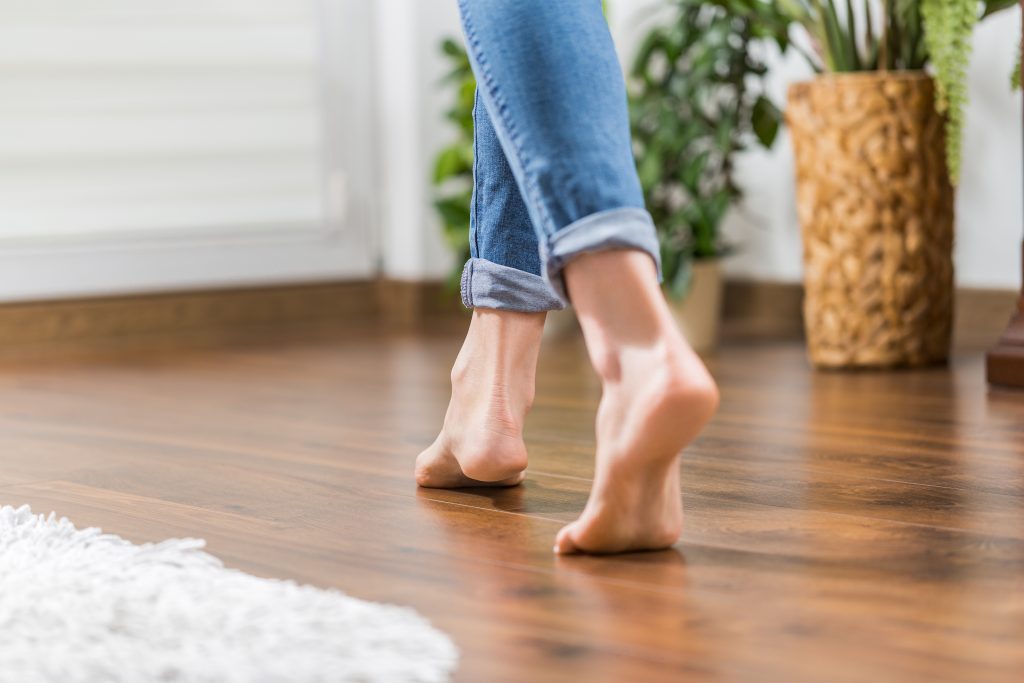
Choosing the Best Wooden Flooring for UFH Systems
Two different types of wooden flooring are generally considered suitable for underfloor heating systems:
Solid Wood Flooring
Many specialists will advise against pairing underfloor heating with a solid wood floor. This is because the floorboards, once laid, are susceptible to movement when exposed to changes in temperature. However, not every type of wood is prone to this kind of reaction; checking with your supplier before you place your order can help to prevent the wrong wood from being chosen.
If your project demands solid wood flooring, most experts would recommend using kiln-dried timber with minimum moisture content (between 6% and 9%). Doing this helps the wood retain its shape during seasonal climatic changes and resist the temperature changes that come with UFH systems.
Engineered Wood Flooring
Most specialists would suggest using engineered wood floorboards, due to their strong structural design. As engineered boards are made up of layers laminated together, they are a more stable product than solid timber. The recommended board width for engineered wood that will be installed over underfloor heating is 150 mm.
Solid wood is not recommended for parquet flooring going over underfloor heating. Only engineered wood should be used.
The Benefits to Using an Engineered Wood Floor
Fitting engineered wood flooring over the top of underfloor heating comes with a range of different benefits:
- Engineered wood floors look like solid wood floors
- The construction of engineered wood makes it more stable than solid wood coverings
- Engineered hardwood flooring can be installed at any floor level, including below street level (solid hardwood floors cannot be installed in basements)
- Engineered wood flooring is often considered to provide a more high-end finish than solid wood
- It will often cost less than solid wood flooring
- It is highly durable and long-lasting
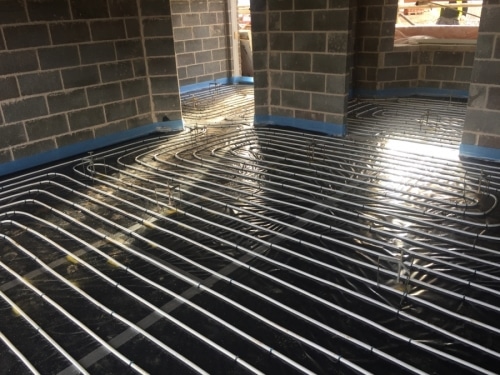
Installing Underfloor Heating Under Wooden Floors
There are several different fixing methods for installing both engineered and solid wood floors over electric and wet underfloor heating systems:
Adhesive
Adhesives can be used to bond timber floorboards to underfloor heating, providing a secure seal between the flooring and the concrete or screed used underneath. Before carrying out this method you should first check with your flooring supplier for recommended primers and adhesives.
Battening
This method involves fixing timber battens across the floor before screeding. When the screed is fully dry, the timber flooring can be attached to the battens using a screw plug or secret-nail fixing. You must take care when nailing or screwing into the battens, otherwise this could damage the floor heating pipes.
Floating
Both solid timber and engineered wooden floorboards are designed to be slotted together (usually tongue and groove style) and can be reinforced using adhesives. These floorboards can then be “floated” over the subfloor where the boards are not fixed down. This is less labour-intensive and saves time, while also making the flooring more resistant to changes in humidity and temperature.
Does Wood Flooring Need to Acclimatise First?
No matter what type of wooden flooring you are intending to use for your planned project, it will need to acclimatise before installation with underfloor heating. This helps to decrease the risk of the timber expanding or contracting once fitted.
To do this, you should lay packs of boards flat in the room that requires flooring for the time recommended by the supplier. Experts suggest that engineered wood will take around 48 to 72 hours to acclimatise. Meanwhile, solid wood can take up to 7 days depending on the wood type and manufacturer.
You should always leave an expansion gap of around 15 mm when fitting underfloor heating underneath timber flooring. This should be left around the perimeter of the room so that the floor has room to expand and contract. The gap can then be concealed with skirting boards.
Problems with Using Wooden Floors for UFH Systems
While wooden floors are highly recommended as coverings for new and retrofit underfloor heating systems, it is not uncommon for there to be problems when using them. However, as long as certain guidelines are followed, these problems can be avoided.
The most common problems and issues associated with underfloor heating and wooden floors will come from the following:
- Dramatic changes in surface temperature or hot spots in the flooring
- A lack of even heat distribution
- Extremely high humidity in a room
- Operating the heating above a surface temperature of 27°C
- Cleaning the floor using too much water
These scenarios have the potential to cause problems such as the following:
- Warped floorboards
- Delamination of engineered wood (the top layer coming off)
- Gaps appearing between floorboards
- The entire floor lifting (if the UFH system is very badly fitted)
- A lack of effective heat transference
To ensure that most of these problems do not occur, both retrofit and new underfloor heating systems should always be provided and installed by professional contractors. These people will have the knowledge and experience necessary to ensure the system is fitted correctly and can advise you on any questions or concerns you may have about the process.
Other methods of preventing problems with underfloor heating and wooden floors include:
- Not turning your underfloor heating off completely for long periods
- Not turning an off system back on and putting it back up to its previous temperature immediately (if you need to do this, do it gradually; turning the system up by a few degrees a day will allow the wood to acclimatise and balance its moisture content. The same applies to decreasing the temperature of the system)
- Clean the wood with appropriate and recommended cleaning products following the manufacturer’s instructions
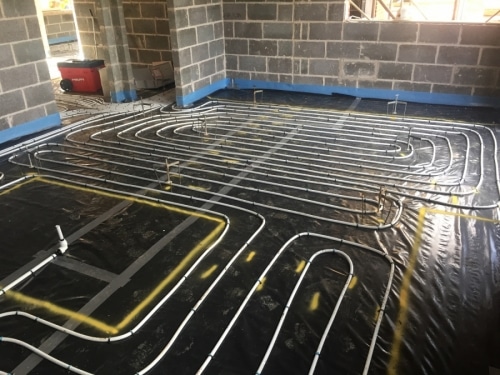
The Cost of Underfloor Heating Over Wooden Floors
How much your underfloor heating and wooden floors will cost can vary greatly, depending on a range of different factors. These include the specifications of your planned work project, the materials and tools that will be used in its completion, and whether or not you will be hiring third-party contractors to install separate elements for you. This is also before you start thinking of running costs, which will be more money on top of what you’ve paid for the price of installation.
We cannot offer more information on the cost of wood flooring. However, as we are specialist providers of wet underfloor heating systems we can discuss prices and ongoing costs for these with you. Contact us directly if you would like to get started on this, or see our information on how much it costs to install and run underfloor heating.
What is the Best Flooring for Underfloor Heating?
The best types of flooring for use with underfloor heating are those that transfer heat to the floor’s surface the most effectively. This is why experts recommend that UFH systems are installed with a layer of screed over the top. When installed correctly, screed fills the gaps and spaces that surround the underfloor heating system, meaning there are no air bubbles that could disrupt the transfer of thermal energy. As a result, the heat is seamlessly and evenly distributed.
To learn more about this, please see our advice on underfloor heating and screed.
If you require another flooring layer above the screed (as it can be left exposed), or above the underfloor heating system if this is the only installation beneath, then other hard surfaces are always highly recommended. Engineered wood flooring, stone, and ceramic tiles are considered the most thermally conductive, but solid hardwood flooring also has the potential to work under the right conditions. It is also possible to install carpets, vinyl, linoleum, and resin over screed and UFH systems, though these do not transfer as much heat quite as easily.

Hiring a Professional Underfloor Heating Contractor
If you have been considering underfloor heating and screed flooring for a planned project before you finish the work by laying down wooden flooring, contact Screed It today.
We are proud of our skill and ability to fit the wet underfloor heating systems that our customers require, and we will be glad to fit yours the way that you have specified. We are also fully prepared to carry out an installation anywhere in the UK, so you can feel confident knowing you’re never out of reach of our service.
Our team will be ready and waiting to discuss what you need as soon as you get in touch. With our assistance, you will be able to make the best decisions possible for your new flooring, so you can move ahead with placing an order and move on to the next stage of your project in no time.
- Categories:
- Blog
Underfloor Heating vs Radiators: Which One is Best for a Project?
When deciding on requirements for a building project, such as heating, you may experience the dilemma of deciding between underfloor heating and radiators. Both do offer their advantages and long term benefits. However, to help settle the question of underfloor heating vs radiators for your work, we’ve created this guide. Here, you will be able to read more about what is better in different circumstances and see comparisons of running and installation costs and energy efficiency.
Read on to learn more, or contact us today if you would like to hear more about the benefits of underfloor heating from our knowledgeable and experienced team.
Is Underfloor Heating Better than Radiators?

Under some circumstances, underfloor heating (UFH) systems may be better than radiator systems. To decide whether or not this is the case in terms of your project, there are a few questions and considerations that you will have to take into account. These include:
- How energy efficient do you need your heating to be?
- Which is more expensive to install?
- Which is more expensive to run in the long term?
- Which is safer?
- Which is more likely to be repaired easily in the event of a breakdown?
- Which is easier to install?
Underfloor Heating vs Radiators: Installation Cost
The first point of consideration is how much both will cost to be installed.
In most cases, UFH systems will be more expensive to install than radiators and come at a higher purchasing cost. This is in part because they will usually require more parts and the installation process itself is likely to be longer. If you’re planning on fitting underfloor heating as part of a renovation project, meaning the system is a “retrofit”, this is also likely to have an impact on the price because the work will be more labour-intensive.
Overall, this gives an immediate advantage to radiators, which usually require fewer parts and can often simply be upgraded or moved during renovation work. This makes them an excellent choice if you are working on a limited budget.
However, the costs involved with installing UFH systems are often later offset by the savings they provide. To learn more about this, please take a look at the information we’ve provided on underfloor heating costs. This advice covers both installation costs and running costs.
Underfloor Heating vs Radiators: Installation Efficiency
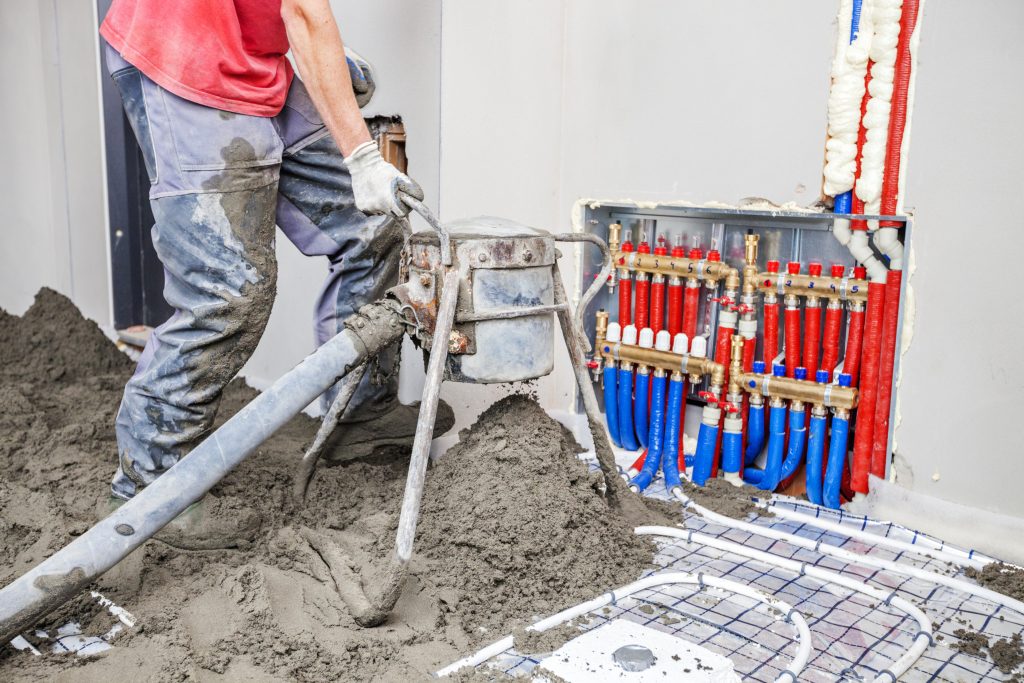
When considering how easy and efficient it will be to install either a set of radiators or underfloor heating, you are also likely to find that the circumstances of your project play a role. If you are intending to replace radiator units with the same or a similar model in a renovation project, then the work shouldn’t take more than a few hours for a specialist to complete.
On the other hand, if you are working on a new build or fitting entirely new and different radiator models (for instance, a vertical model instead of a conventional horizontal one) you may need extra time to plan where they will be placed. An entire room or more may have to be reworked around the position of a radiator to ensure the heat output is efficient enough.
Similarly, the ease of installing an underfloor heating system will depend on the type of project you are working on. Naturally, it is more straightforward to install a UFH system as part of a new build or completely new extension, as it can be laid before a screed level or when the final flooring is put down. Installing underfloor heating as a retrofit in a renovation project is more difficult than this, as you will most likely have to dig up the floor.
An electric underfloor heating system may be easier to install than a wet system in either case, as you will need to allow room for the pipework to be installed without too great a height build-up. There are slim systems available for retrofit work that can help to mitigate this, though.
Underfloor Heating vs Radiators: Efficiency at Heating a Home

In terms of heating your home, underfloor heating systems are regularly reported as offering greater levels of efficiency. As the system heats the room from the floor up, it will give an even heating profile and prevent cold spots far more effectively than having radiators installed. As UFH is also controlled by thermostats in different rooms or “zones”, you can also set each one to your preferred temperature and keep every part of your property as warm as you like.
Meanwhile, radiators are normally all part of one central heating system that is controlled by a single thermostat and thermostatic radiator valves (TRVs). These adjust the amount of hot water that enters specific radiators but is less efficient and convenient than adjusting a thermostat. As they are fixed to one location, the room is also likely to feel colder than one that is being heated evenly.
Underfloor Heating vs Radiators: Energy Efficiency
The one fact that most people are aware of about underfloor heating is that it is better than having radiators when it comes to energy efficiency. UFH systems, especially wet systems, work at a lower flow temperature than radiators, meaning that they can run from an existing boiler.
Pairing underfloor heating with heat pumps, which also work most efficiently at lower temperatures, raises the levels of efficiency even more. Most radiators are compatible with standard boilers but are not recommended for heat pumps because of the higher water temperatures they require.
This helps to make it more green and efficient to heat your home using underfloor heating, but further savings are made by the fact that UFH spreads out over and heats a large surface area. The distribution of heat means that objects in a room will be heated directly and a room’s natural humidity will be maintained, keeping the spread even. Conventional radiators, on the other hand, will warm one area and then take time to circulate so that the temperature in the room reaches the desired level. This often leads to owners turning them up to reap the same benefits as they would with UFH, increasing the amount of energy used.
It is important to bear in mind that achieving energy-efficient heating is only truly possible if a property has a good thermal performance. If a property isn’t insulated or is poorly insulated, the heat generated will not be trapped and allowed to circulate. This can often cost homeowners money, as their energy bills will not be reduced.
Bearing all of this in mind, you should see that most energy efficiency and savings can be achieved by using a wet underfloor heating system and having a well-insulated home.
Underfloor Heating vs Radiators: Overall Practicality

One factor is how practical having radiators is against how practical it would be to have underfloor heating installed. This can be split into several different considerations:
- How safe both are
- How much room each provides or takes up
- The lifespan of both systems
- The repairability of both systems
In terms of safety, underfloor heating systems will always beat conventional radiators. They provide the warmth and comfort required but as you can’t touch their surfaces, it isn’t possible to be scalded by them. There are also no exposed sharp edges or pipes that people could catch themselves on.
As nothing is exposed with UFH, you should also find that you have a higher amount of space to furnish and decorate. Radiators, on the other hand, take up wall space and reduce the options that you have for choosing the room design that you want.
The issues of lifespan and maintenance may be one of the most relevant deciding factors in determining what system is better for your project. Depending on the model, radiators may have a lifespan of anywhere between 8 and 15+ years, though frequent use will result in these wearing down over time and requiring maintenance. Flushing them regularly can help to prevent rust and other substances from building up, which may extend their lifespan.
The pipework of a wet underfloor heating system will also require flushing and regular servicing but should last for around 50 years if kept in its best condition. We should note, however, that as regular radiators are more common, it is more likely that professionals will have seen and know what to do if one breaks down. They are also easier to fix, as they are exposed and accessible. You will need to ensure that you get a specialist who knows how to take care of UFH if you choose this as your heating system.
Underfloor Heating vs Radiators: Running Costs
As underfloor heating is more eco-friendly and energy efficient than radiators, and will not have to be turned up as high for a person to feel the benefits, they also offer a homeowner better running costs. They’re particularly effective in doing this for homes that have already been built to be green (or in new builds that are going to be green once fully built) but can also offer savings in properties that have not been designed with this in mind. As long as the system is installed properly it may be up to 25% more efficient than a standard radiator, or even 40% more efficient when installed with a heat pump.
Can Underfloor Heating Replace Radiators?
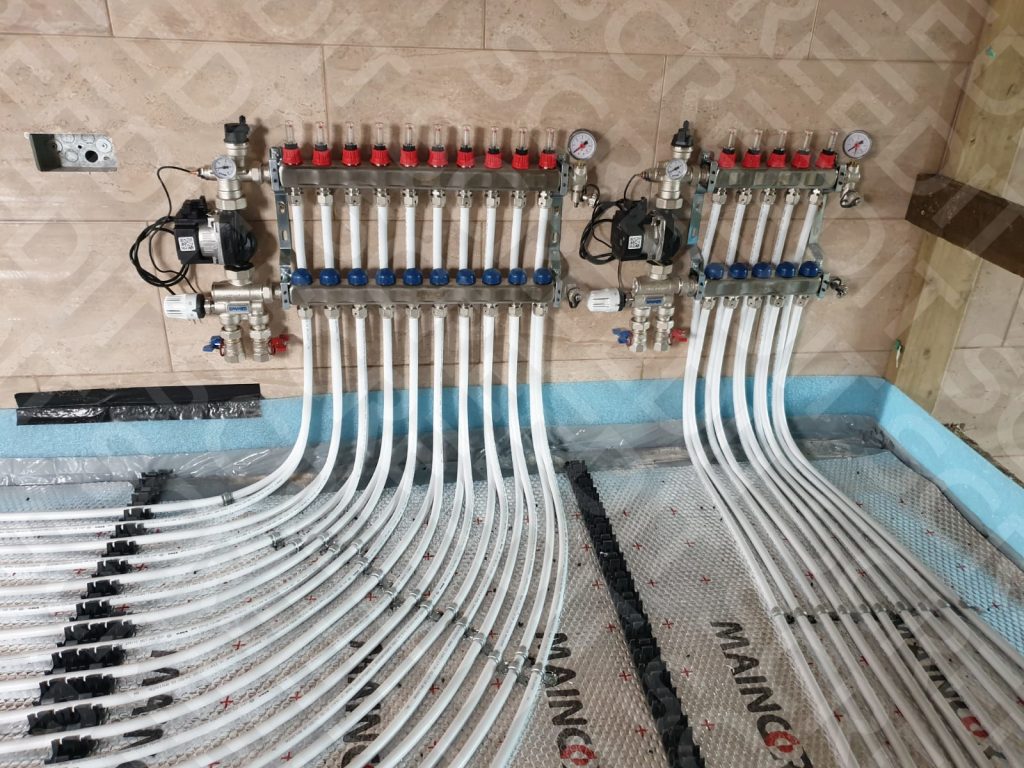
Underfloor heating systems can replace radiators in a home. Depending on the size of a property and the amount of heat lost from certain rooms and areas, it may even be possible for UFH systems to replace radiator systems throughout an entire property. If you would prefer not to do this, you can also choose to install underfloor heating in part of your property, such as the downstairs area or a new extension, and heat the upstairs with conventional radiators.
To decide whether or not it would be economical and beneficial for your property to have some of its radiators replaced with underfloor heating, consider the points we have listed above. To decide whether or not all of them can be replaced with underfloor heating, you will then need to conduct a heat loss calculation on top of this.
Heat loss calculations tell you whether the heat output of a UFH system meets the heating requirement of any one particular room or area. To know whether or not your room is heated sufficiently, you will have to see if the maximum heat output from the system is greater than the amount of heat lost.
If the amount of heat generated by a UFH system is greater than the amount of heat lost, you should be able to comfortably replace a property’s radiators.

Contacting a Professional Underfloor Heating Contractor
If you have been considering a screed floor for a planned work project and believe that the result will also benefit from having an underfloor heating system fitted, contact Screed It today. We pride ourselves on our expertise and ability to install the wet underfloor heating that our customers need, and we can ensure that yours is installed exactly as you require. We are also ready to carry the work out anywhere in the UK, so you are always guaranteed to be within reach of our services.
One of our team will be waiting to discuss the terms and specifications of your project as soon as you get in touch. With our help, you’ll be able to make the best decision for the flooring of your project, so that you can move ahead with placing an order for the screed and underfloor heating installation that meets the needs of your project.
- Categories:
- Blog

